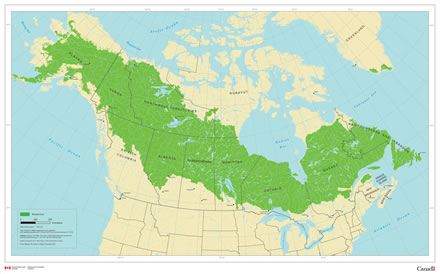8 facts about Canada's boreal forest

Canada’s boreal forest covers a vast part of our country, yet there are many things you may not know about it.
For example, do you know the difference between the “boreal forest” and the “boreal zone”? The boreal zone is the wide area that lies between the treeless tundra of the arctic zone in northern Canada and the temperate zone in southern Canada. The boreal forest is the forested area within the larger boreal zone.
Here are 8 more facts about the boreal zone and Canada’s boreal forest.
1. The boreal zone circles the world
The world’s boreal zone is often called “circumpolar” because it circles the Northern Hemisphere, forming a ring around the North Pole, just south of the Arctic Circle. Countries with forests and land in the boreal zone include Canada, the United States, Norway, Sweden, Russia, China and a few others.
Worldwide, the boreal zone covers:
- 1.9 billion hectares
- 14% of Earth’s land
- 33% of Earth’s forested area
Canada has:
- 28% of the world’s boreal zone – that's 552 million hectares
- 75% of all of its forests and woodlands in the boreal zone – that’s 307 million hectares in total
2. Mapping of North America’s boreal zone is based on science

As the map shows, Canada’s boreal zone stretches from Yukon and northern British Columbia to Newfoundland & Labrador. Canadian Forest Service researchers have used the most current science to map the North American part of the boreal zone.
This map gives scientists, governments and others a common tool for discussing the boreal region.
Download a printable version of the map as a PDF [2.2 Mb] or the shapefiles.
3. The boreal zone includes both forests and treeless areas
Much of Canada’s boreal zone is covered in forested lands that are made up of trees, such as pine, spruce, larch, fir, poplar and birch. More than just one big forest, the boreal zone also includes
- thousands of lakes, rivers and wetlands
- many naturally treeless areas such as on mountains and in coastal regions
4. The boreal zone is home to a wide range of animals
The boreal zone is home to an extensive range of mammals, insects, fungi and micro-organisms. Among them are:
- 150 bird species – which is half of the bird species in Canada
- Woodland caribou – or boreal caribou, as the population in the boreal zone is known, which like to stay in the forests rather than roam the tundra like other caribou.
5. Many people live and work in the boreal zone
- 3.7 million people in the world live in the boreal zone, mostly in remote and rural communities.
- 70% of Aboriginal communities in Canada are located in forested regions. The boreal forest is culturally and economically significant to Canada's Aboriginal peoples.
6. The boreal forest isn’t “ancient” wilderness
Canada’s boreal forest is often portrayed as one vast tract of ancient, pristine wilderness but this isn’t the case. Although the boreal region itself is ancient, the boreal forest:
- is made up mostly of trees that are relatively young compared with many that grow in more temperate climates
- is regularly affected by forest fire, insects and other natural disturbances
- continually renews itself through these natural disturbances
Read more: “Is Canada's boreal forest ancient? ”
7. Forest fires, insects and diseases help the boreal forest
The boreal forest needs natural disturbances such as forest fires and outbreaks of insects and disease. These disturbances:
- remove aged trees from the forest
- expose the land to sunlight again
- allow the next group of trees to germinate and grow into a new forest
- release nutrients from the trees
Learn more about natural disturbances in our forests.
8. Canada’s boreal forest is sustainably managed
Sustainable forest management ensures that the boreal, and all of Canada’s forests, are healthy, safe and thriving. Forest companies have to replant or seed all the areas they harvest on public land, including in the boreal forest, or allow the forest to grow back.
Learn how Canada protects our boreal forest
The boreal forest is important to Canada’s environment, society and economy. Learn more about the ways Canada values and protects our boreal forest.
Page details
- Date modified: